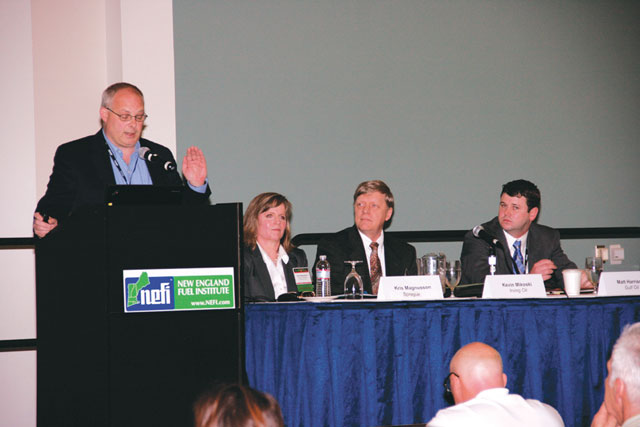All
Specification Changes Challenge Marketers, Wholesalers

Energy marketers and petroleum wholesalers in the Northeast face a fresh set of challenges this year as the state specifications for heating oil shift unevenly, leaving the New York and the six New England states with three different specifications for one fuel.
Representatives of four petroleum wholesalers shared thoughts on the effects of the specification changes during a panel discussion at the recent 2014 Visions Conference, sponsored by New England Fuel Institute.
The hodgepodge of heating oil varieties results from the ongoing transition to ultra low sulfur heating oil, which is occurring on a state-by-state basis. The changeover began two years ago, when New York State went directly from high-sulfur heating oil to the cleanest available option, which is heating oil containing no more than 15 parts per million (ppm) of sulfur.
Four New England states – Connecticut, Massachusetts, Rhode Island and Vermont, are taking a more gradual approach. They switched to a medium-grade fuel with a 500ppm sulfur limit as of July 1, 2014.
Maine and New Hampshire, meanwhile, continue to use traditional heating oil with up to 4,000 ppm of sulfur. Maine is scheduled to shift to reduced-sulfur heating oil in 2016, while New Hampshire has not set a transition date.
Questions Abound
With so many sulfur levels in play and so much demand uncertainty due to weather, conservation and fuel conversion, wholesalers and retailers alike have a lot on their minds. The Visions Conference panelists acknowledged the difficulties but assured the hundreds of marketers in attendance that they will be able to get exactly the product they need.
Bill Braunig, Wholesale Risk Manager at Global Partners, said there is no index quoting 500 ppm sulfur heating oil yet, but it will come. The fuel will be a blended product, because refiners are not planning to make fuel to a 500ppm specification, he said. “Heating oil is turning into a blend stock,” he said. The refineries will continue to make high sulfur product, but the market will determine how long that will go on, he added.
Kevin Mikoski, Manager of Risk Management and Value Added Customer Services at Irving, some marketers have asked why wholesalers don’t simply flip the switch and sell only ULS heating oil. “That would not be such a good thing,” he explained, noting that refineries in PADD 1 can’t produce enough ULS fuel to serve the region and the pipelines are not ready to pick up the slack. “If it all changed at once, there’d be real supply issues. It all takes time to convert,” he added.
Marketers are watching the bottom line, and as long as there is money to be saved by selling higher sulfur fuel, that fuel will be available. “It all depends on the spread,” he said. He noted that Irving is currently selling both 500ppm and 15ppm product in Revere, Mass.
Irving tried to transition its supply in Revere to 15 ppm a few years ago, but marketers resisted. “When it comes to price, people don’t want to pay a penny or two more,” he said. “As long as there is a spread with a penny or two, then people will have 500ppm.”
Kris Magnusson, Manager of Program Development for Refined Products at Sprague, said the market would ultimately determine what happens with sulfur levels. It will be interesting to see if refiners stop producing high-sulfur fuels in order to start retooling to produce reduced-sulfur fuels, she said. It comes down to what will be available,” she said. “During parts of last winter you were getting 15ppm product, because that’s what we could get our hands on,” she added.
Matt Harrison, Senior Marketing Manager at Gulf, said there are suppliers along the Connecticut/New York border who supply both ULS and higher-sulfur products. “It’s up to the retailer whether they have the storage and can dedicate the trucks [to deliver two different fuels],” he said.
Related Posts
 The Possibilities of Renewable Propane
The Possibilities of Renewable Propane
Posted on March 13, 2024
 Propane Can Do That
Propane Can Do That
Posted on March 12, 2024
 Take Action and Take Control of Your Future at Industry Summit VI and Visions ‘24
Take Action and Take Control of Your Future at Industry Summit VI and Visions ‘24
Posted on March 11, 2024
Enter your email to receive important news and article updates.

